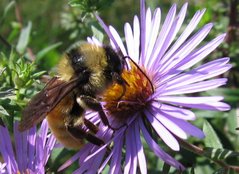Presquile Provincial Park, Brighton, Ontario
September 8, 2005
Although common in the U.S. this tree occurs only in the extreme south of Ontario. The USDA Forest Service website says this about the importance of Dogwood to wildlife:
"Flowering dogwoods are extremely valuable for wildlife because the seed, fruit, flowers, twigs, bark, and leaves are utilized as food by various animals. The most distinguishing quality of dogwood is its high calcium and fat content (5). Fruits have been recorded as food eaten by at least 36 species of birds, including ruffed grouse, bob-white quail, and wild turkey. Chipmunks, foxes, skunks, rabbits, deer, beaver, black bears, and squirrels, in addition to other mammals, also eat dogwood fruits. Foliage and twigs are browsed heavily by deer and rabbits."
September 8, 2005
Although common in the U.S. this tree occurs only in the extreme south of Ontario. The USDA Forest Service website says this about the importance of Dogwood to wildlife:
"Flowering dogwoods are extremely valuable for wildlife because the seed, fruit, flowers, twigs, bark, and leaves are utilized as food by various animals. The most distinguishing quality of dogwood is its high calcium and fat content (5). Fruits have been recorded as food eaten by at least 36 species of birds, including ruffed grouse, bob-white quail, and wild turkey. Chipmunks, foxes, skunks, rabbits, deer, beaver, black bears, and squirrels, in addition to other mammals, also eat dogwood fruits. Foliage and twigs are browsed heavily by deer and rabbits."


3 comments:
Nice photo, especially the larger version where you can see the rainwater dripping from the fruit. Dogwoods are lovely trees, and I remember them fondly from when I lived in Virginia.
Hi guy,
Are you sure this if Flowering Dogwood? While it seems to have opposite leaves - as does fl. dogwood - the leaves in your photo have heavily forked veins. Dogwoods usually have parallel veins and a smooth outline. As well, the fruit clusters on fl. dogwood are usually denser and upright and have fewer fruit, which are also more oblong, not so rounded. Might it have been some species of Viburnum? Fl. dogwood also doesn't occur naturally in Ontario any further northeast of Toronto.
Justin
Hi Justin:
Thanks for taking the time to comment. I'm not certain at all. It was my best guess based on pictures I looked at one the internet. I did have a question in my mind about the veins in the leaves. I'll have to take another look at it.
Post a Comment